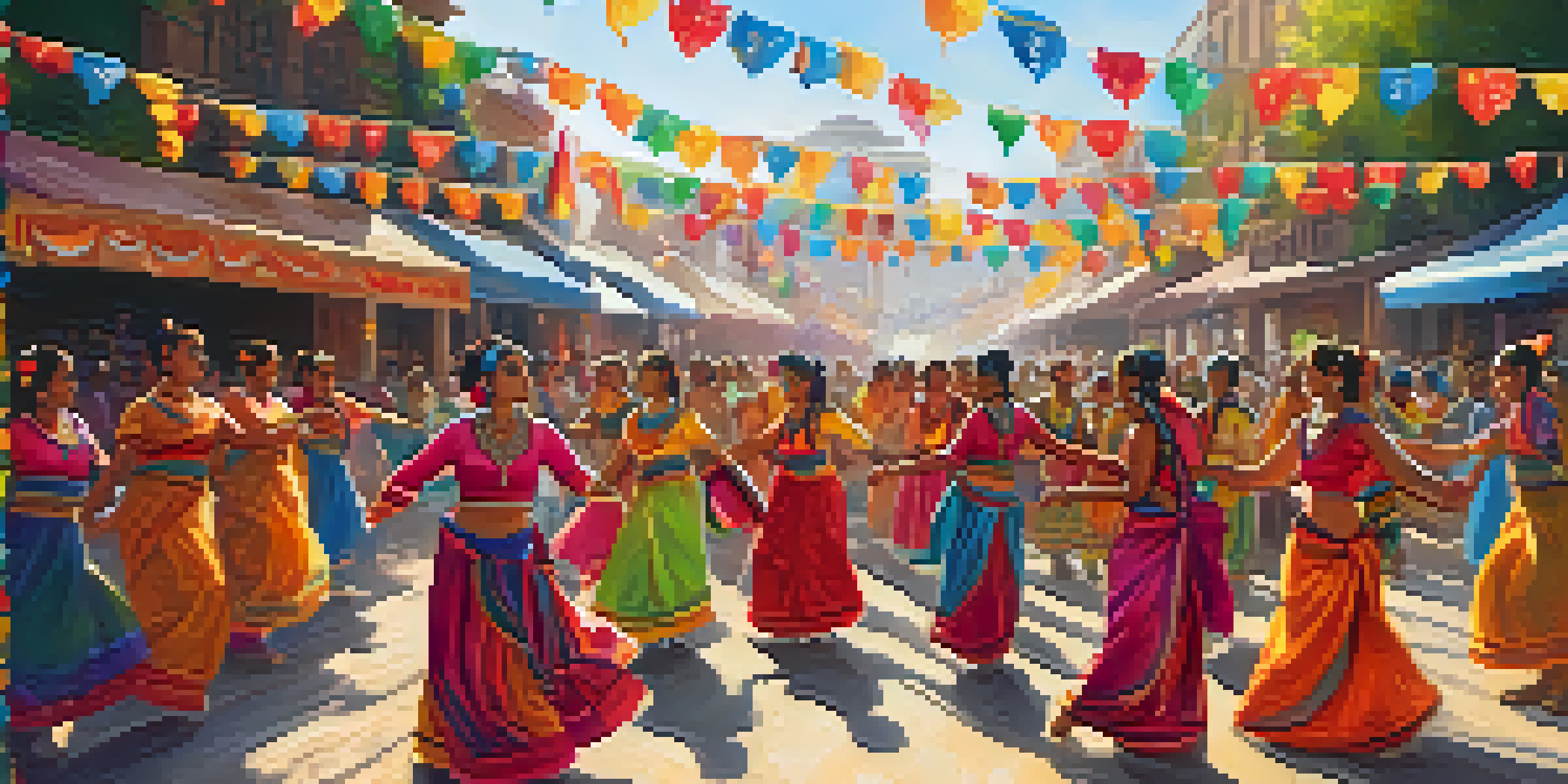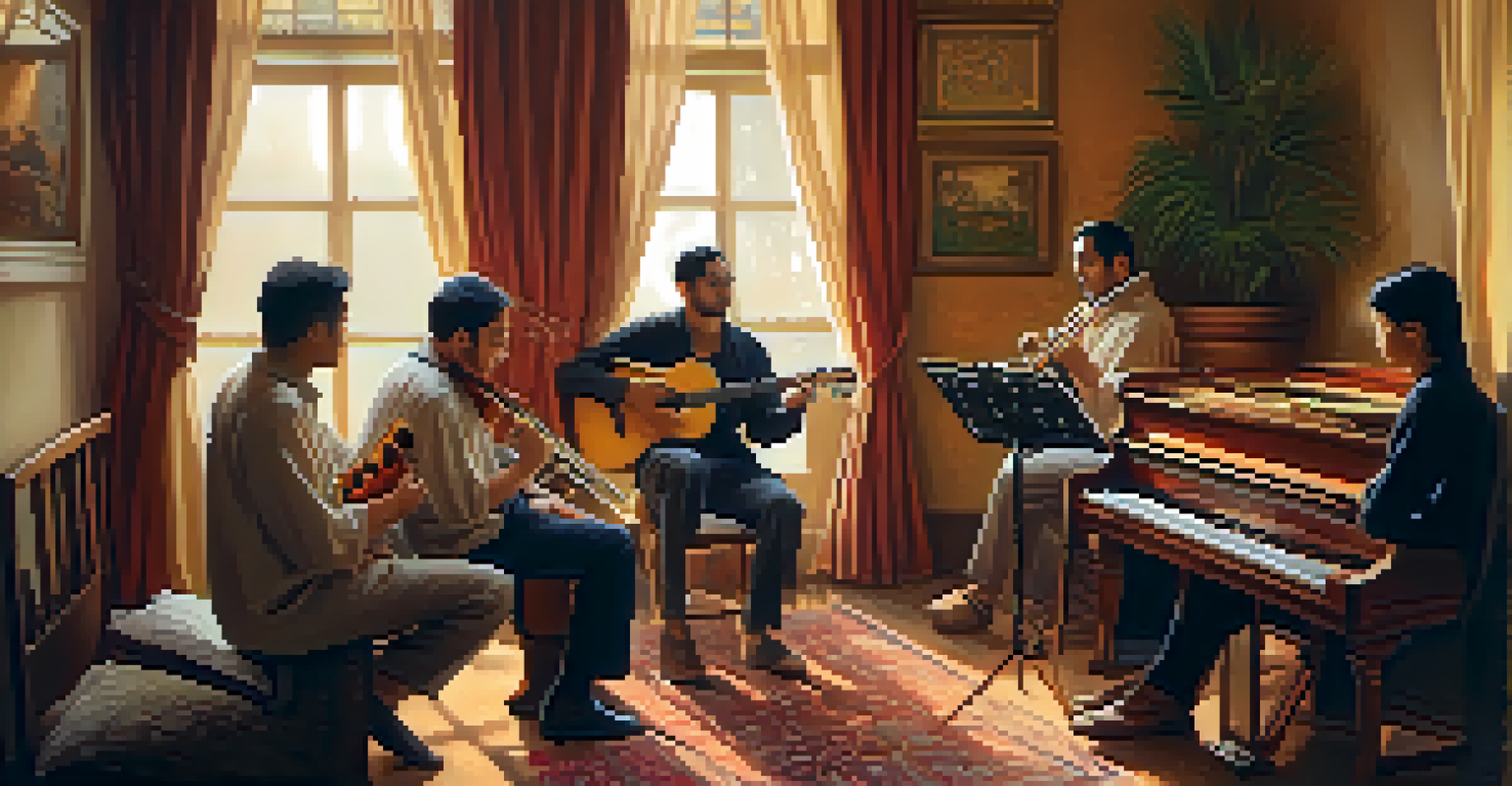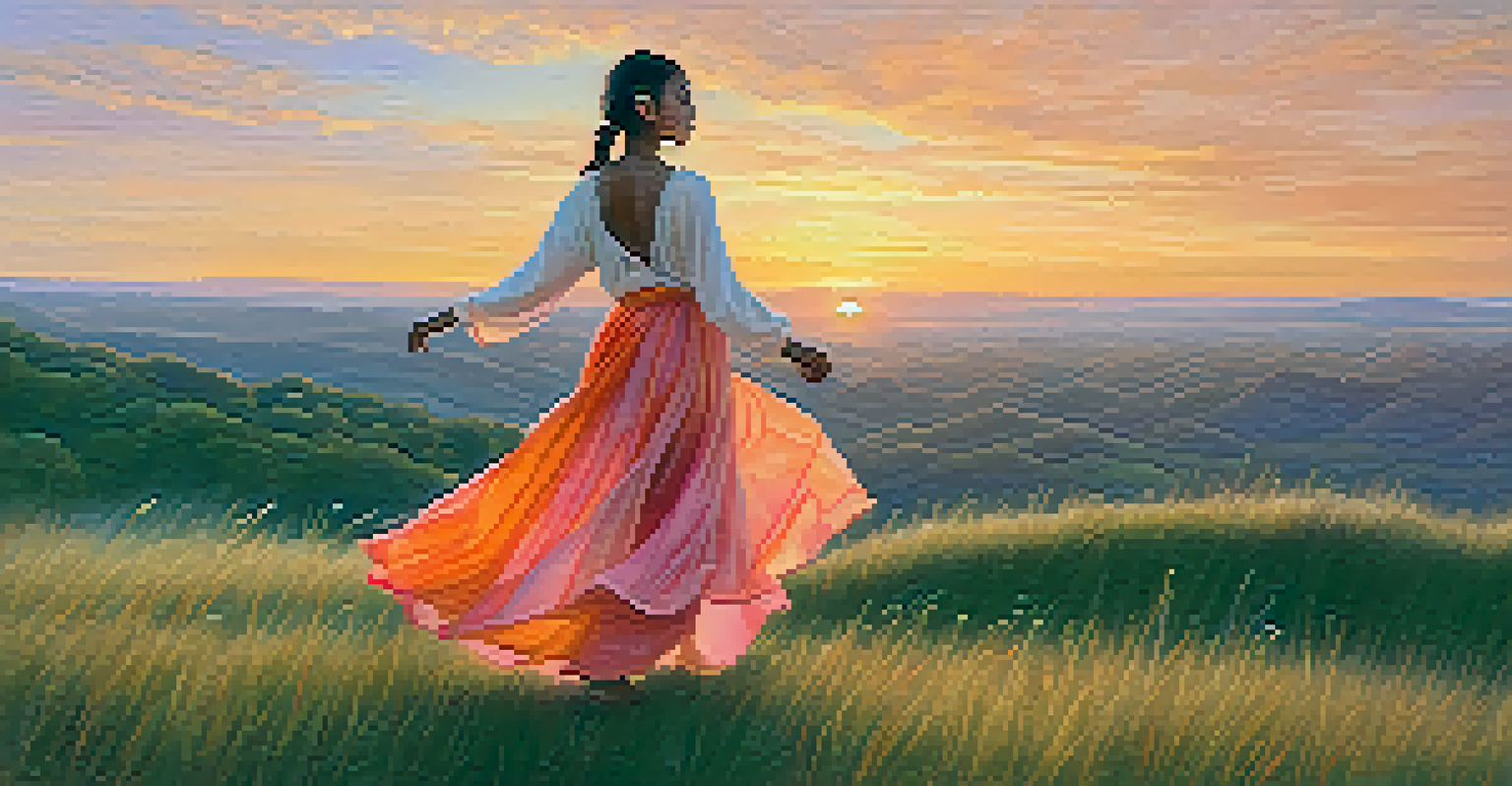Exploring Cultural Narratives Through Dance and Music

The Universal Language of Dance and Music
Dance and music serve as powerful forms of expression, transcending language and geographical barriers. These art forms allow individuals to share their emotions, stories, and cultural heritage in a way that words often cannot. For instance, a joyful dance can convey celebration, while a melancholic tune can express sorrow, connecting people to shared experiences.
Dance is the hidden language of the soul.
When we observe different cultural dances and music styles, we witness a rich tapestry of narratives that reflect the values and histories of various communities. From the rhythmic beats of African drumming to the graceful movements of ballet, each style tells its own story, rooted in tradition and history. This universality fosters a sense of community and understanding among diverse cultures.
Moreover, dance and music often evolve over time, integrating new influences while still honoring their origins. This fluidity allows for cultural narratives to be continually reinterpreted and shared, ensuring that the essence of a community’s story remains vibrant and relevant, even in a changing world.
Cultural Identity Expressed Through Movement
For many cultures, dance is a vital component of identity, serving as a means to celebrate heritage and convey social values. For instance, traditional Hawaiian hula not only entertains but also tells the stories of the land, ancestors, and the beauty of nature. Through movement, participants honor their past while engaging with their present.

The intricate rhythms and steps in various dance forms can evoke strong emotions that resonate deeply within communities. For instance, flamenco dancing from Spain is not just an art; it is a passionate expression of the struggles and joys of life, connecting dancers to their cultural roots. Each performance becomes a personal narrative, intertwining individual stories with collective history.
Dance and Music Unite Cultures
Dance and music transcend language barriers, allowing individuals to share emotions and cultural heritage across diverse communities.
As cultures interact and blend, new dance forms emerge, further enriching the narrative landscape. Consider the fusion of hip-hop with traditional African dance, which creates a lively dialogue between the past and the present, illustrating how cultural identities are not static but dynamic and ever-evolving.
Storytelling Through Rhythm and Melody
Music has long been a vessel for storytelling, encapsulating the essence of cultural narratives. From ballads that recount historical events to modern songs that address social issues, music reflects the realities of life within a culture. A song can serve as a powerful reminder of a community's struggles, triumphs, and aspirations.
Music can change the world because it can change people.
In many cultures, the lyrics of songs are steeped in symbolism, often carrying deeper meanings that may not be immediately apparent. For example, the folk songs of the Appalachian region tell tales of hardship and hope, connecting listeners to the land and its history. These narratives resonate not just with those who share the culture, but with anyone who appreciates the universal themes of love, loss, and resilience.
Additionally, the collaboration of musicians across cultures can create a rich tapestry of sounds that tell new stories. The blending of different musical styles—like reggae and jazz—creates innovative expressions that celebrate diversity and foster understanding, showing that while each culture has its unique narrative, they can also harmonize beautifully.
The Role of Festivals in Cultural Expression
Festivals often serve as vibrant showcases for cultural narratives through dance and music, bringing communities together in celebration. Events like Diwali in India feature traditional dances and music that tell stories of victory and light triumphing over darkness. These gatherings create a sense of belonging and pride as individuals share their cultural heritage.
During festivals, the energy is palpable, as participants engage in performances that highlight their unique traditions. For instance, the Brazilian Carnival is a grand celebration filled with samba music and dance, each performance telling a story of history, struggle, and joy. These events not only entertain but also educate attendees about the cultural significance behind each movement and melody.
Cultural Identity Through Movement
Many cultures use dance as an expression of identity, celebrating heritage and social values through intricate rhythms and storytelling.
Moreover, festivals often invite cross-cultural interactions, allowing people to experience diverse traditions firsthand. This exchange fosters appreciation and respect for different cultural narratives, as participants learn that, despite differences, the themes of joy, love, and community are universal.
Dance and Music as Agents of Social Change
Throughout history, dance and music have played crucial roles in movements for social change. Artists have used their craft to raise awareness about social injustices, inspiring action and solidarity among communities. For instance, the civil rights movement in the United States saw musicians and dancers use their talents to convey messages of equality and freedom.
Songs like 'We Shall Overcome' became anthems, uniting people in their fight against oppression. Similarly, dance performances often serve as powerful statements, challenging societal norms and encouraging dialogue about critical issues. This ability to engage audiences emotionally makes art a potent tool for advocacy and change.
Moreover, as global challenges arise, such as climate change or inequality, artists continue to respond through their work. Collaborative projects that fuse various cultural expressions can amplify these messages, highlighting the interconnectedness of our struggles and the power of community in effecting change.
The Preservation of Cultural Heritage
Dance and music are essential for preserving cultural heritage, as they carry traditions and stories from generation to generation. Many communities actively engage in teaching these art forms to younger generations, ensuring that their history remains alive. For example, Native American powwows are gatherings where traditional dances and songs are performed, allowing cultural practices to thrive.
Through the preservation of these art forms, communities not only maintain their unique identities but also share their heritage with the broader world. This sharing fosters cultural pride and encourages others to appreciate and respect different traditions. It’s a beautiful cycle of learning and growth that strengthens community bonds.
Art as a Tool for Social Change
Throughout history, dance and music have been powerful agents for social change, raising awareness and inspiring action against injustices.
Additionally, as globalization increases, the preservation of cultural narratives through dance and music becomes even more critical. By celebrating and protecting these art forms, cultures can resist homogenization and ensure that their unique stories continue to thrive amid a rapidly changing world.
The Future of Dance and Music in Cultural Narratives
As we look to the future, dance and music will undoubtedly continue to evolve, reflecting the changing dynamics of culture and society. New technologies, like virtual reality and social media, are already reshaping how artists create and share their work, allowing for broader audiences to engage with diverse narratives. This evolution can lead to innovative forms of expression that honor tradition while embracing modernity.
Furthermore, the blending of different cultural influences presents exciting opportunities for new narratives to emerge. Collaborative projects that unite artists from various backgrounds can produce fresh sounds and movements, illustrating the beauty of cultural exchange. This fusion not only enriches the art forms but also promotes understanding and unity among diverse communities.

Ultimately, as we continue to explore cultural narratives through dance and music, we must remain committed to fostering inclusivity and respect for all traditions. By valuing the stories behind these art forms, we can ensure that they remain vibrant, relevant, and capable of connecting us in profound and meaningful ways.